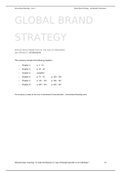International Branding – Year 4 Global Brand Strategy – Jan-Benedict Steenkamp
GLOBAL BRAND
STRATEGY
WORLD-WISE MARKETING IN THE AGE OF BRANDING
JAN-BENEDICT STEENKAMP
This summary includes the following chapters:
¬ Chapter 1: p. 1 – 12
¬ Chapter 2: p. 19 – 43
¬ Chapter 3: complete
¬ Chapter 4: p. 75 – 95 p. 100 – 109
¬ Chapter 5: p. 111 – 119 p. 126 – 147
¬ Chapter 8: p. 209 – 213 p. 220 – 227
This summary is made for the Year 4 International Communication – International Branding exam.
Idiosyncrasies meaning: “a mode of behaviour or way of thought peculiar to an individual.” 21
,International Branding – Year 4 Global Brand Strategy – Jan-Benedict Steenkamp
TABLE OF CONTENTS
Chapter 1 – P. 1 - 12..............................................................................................................................4
The cambrian Explosion of Brands.....................................................................................................4
The global branding phenomenon.................................................................................................4
Why consumers value brands........................................................................................................5
The role of business brands...........................................................................................................6
The global competition for consumers and business customers...................................................6
Chapter 2 – P. 19 – 43............................................................................................................................7
The COMET Framework: How global brands create value.................................................................7
Customer preference.....................................................................................................................7
Organizational benefits..................................................................................................................8
Marketing benefits (in the book: Superior marketing programs)..................................................9
Media spillover across countries....................................................................................................9
Pooling marketing resources across countries...............................................................................9
Economies of scale.........................................................................................................................9
Transnational innovation...............................................................................................................9
The COMET scorecard..................................................................................................................10
Chapter 3 – Complete..........................................................................................................................12
Customer Propositions For Global Brands.......................................................................................12
According to Steenkamp, there are five categories of customer propositions:...........................12
Value brands................................................................................................................................12
Mass brands.................................................................................................................................13
Premium brands..........................................................................................................................15
Prestige brands............................................................................................................................15
Fun brands...................................................................................................................................16
Developing a customer proposition for your brand.....................................................................18
Blueprint for a one-sentence customer proposition....................................................................18
Chapter 4 – P. 75 – 95 / P. 100 – 109...................................................................................................20
Global Marketing Mix Decisions: Global Integration, Not STandardization.....................................20
Global integration options...........................................................................................................20
Brand Name.................................................................................................................................20
Product........................................................................................................................................21
Pricing..........................................................................................................................................21
Advertising...................................................................................................................................22
Sales promotion...........................................................................................................................23
2
,International Branding – Year 4 Global Brand Strategy – Jan-Benedict Steenkamp
Global sales strategy....................................................................................................................23
Global distribution strategy.........................................................................................................24
Chapter 5 – P. 111 – 119 / p. 126 – 147...............................................................................................27
Global Brand Building In The Digital AGe.........................................................................................27
Digital sales channels...................................................................................................................27
Co-creation of global brand strategy...........................................................................................28
Transparency...............................................................................................................................30
Connectivity.................................................................................................................................30
Internet of Things........................................................................................................................33
Managerial takeaways.................................................................................................................34
Chapter 8 – P. 209 – 213 / P. 220 – 227...............................................................................................35
Corporate Social Responsibility.......................................................................................................35
A framework for CSR branding.....................................................................................................35
CSR activities................................................................................................................................36
Integrating CSR into the brand proposition.................................................................................36
Communicating CSR to customers...............................................................................................37
3
, International Branding – Year 4 Global Brand Strategy – Jan-Benedict Steenkamp
CHAPTER 1 – P. 1 - 12
THE CAMBRIAN EXPLOSION OF BRANDS
Technological progress in the late nineteenth century outstripped the average consumer’s ability to
understand the products, let alone know their producers personally. In response to customer uncertainty,
firms started to introduce brands in various industries, ranging from steel and armaments, automobiles (Ford,
Mercedes), and banks (Rothschild) to toothpaste (Colgate), soap, and soft drinks (Coca-Cola).
In what we might call the “Precambrian” era of branding, a diversity of brand-savvy entrepreneurs emerged.
One of world’s first consumer brands was Sunlight. Sunlight was a soap manufacturer, established in 1884 by the
Lever brothers. They were the first ones to market their products in a different way and advertise their products.
In 1930, Sunlight merged with the Dutch company Margarine Unie, to become Unilever, still one of the largest
consumer packaged goods firms in the world.
The global branding phenomenon
With the advent of mass media in the 1960s, the pace of brand introduction, sophistication, and importance
accelerated dramatically. The world has witnessed a “Cambrian explosion” of brands.
The term Cambrian explosion of brands is inspired by one of the greatest explosion of species in the history of the
world, which took place in a relatively short time (geologically speaking) of about 20-25 million years in the
Cambrian era, which started 546 million years ago.
The digital revolution of the twenty-first century with cheap mobile, big data, social media, and global
connectivity has further accelerated this process. Brands have become ubiquitous in today’s marketplace.
! Steenkamp defines a global brand as: “a brand that uses the same name and logo, is recognized,
available, and accepted in multiple regions of the world, shares the same principles, values, strategic
positioning, and marketing throughout the world, and its management is internationally coordinated,
although the marketing mix can vary.”
Steenkamp does not use a market share criterion in his definition as he beliefs that confounds strategy with its
outcomes and restricts it to prove successes as opposed to emerging successes. In principle, a global brand has
broadly the same positioning around the world.
For most global brands, the marketing mix will vary (somewhat) to meet local needs and competitive
requirements.
The rise and dominance of global brands is a logical consequence of one of the axial principles of our time, the
globalization of the marketplace, accelerated by rapidly falling transportation and communication costs.
Other factors contributing to global integration of markets include:
¬ Falling national boundaries
¬ Regional unification (EU, ASEAN, NAFTA)
¬ Global standardization of manufacturing techniques
4





